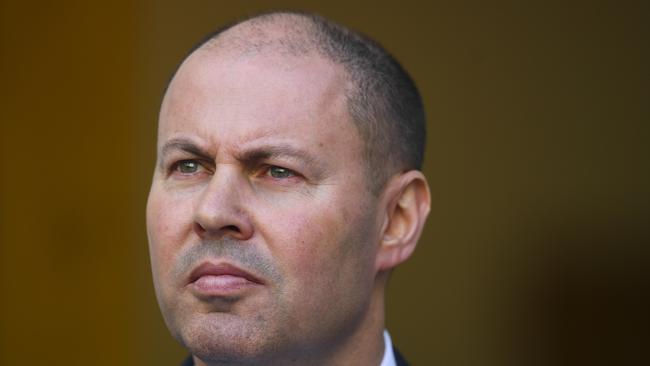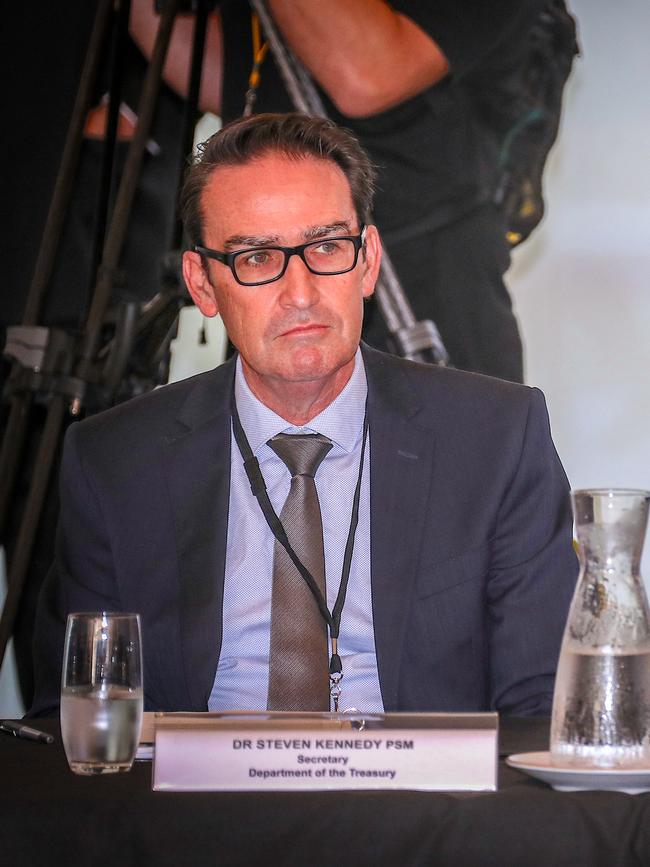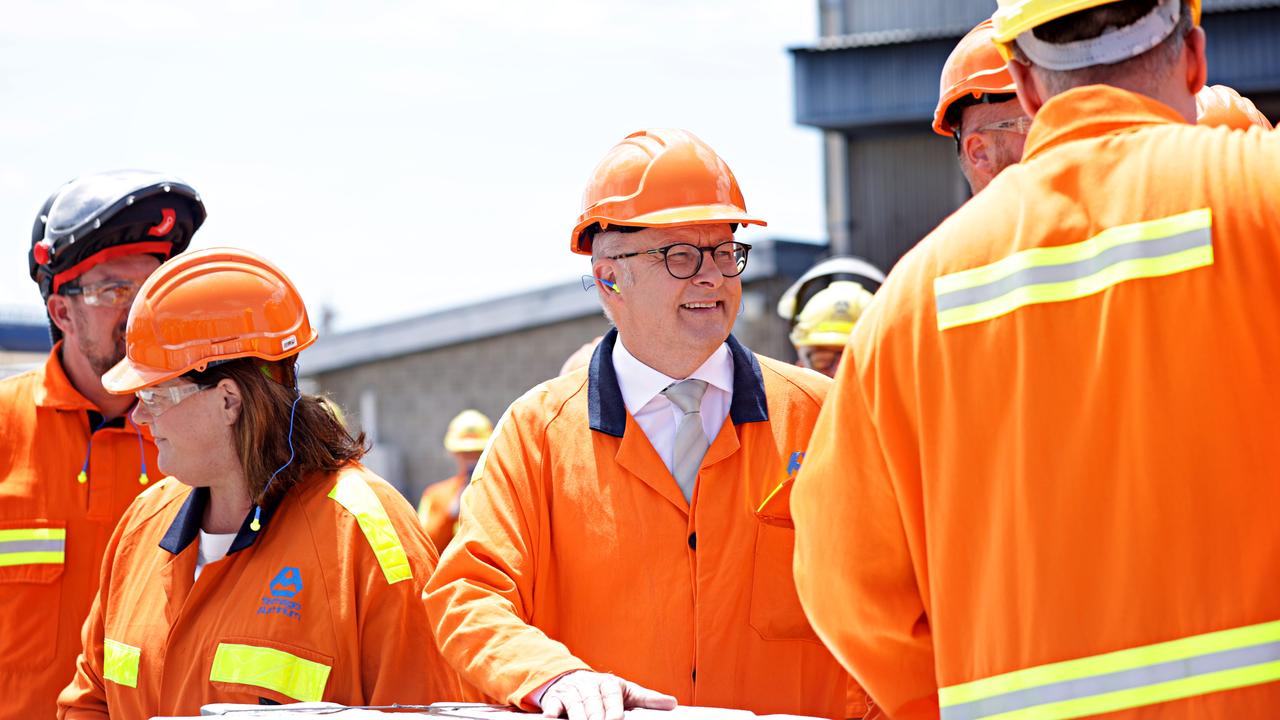
The key decisions on the size of the government’s fiscal stimulus package emerged from the 10-hour meeting on Monday March 9, when Josh Frydenberg was at the Treasury in Canberra and Treasury chief Steven Kennedy told him “you need a package close to 1 per cent of GDP”.
“We had a Turkish meal. It was myself, Steven Kennedy and the Treasury deputies,” the Treasurer told The Weekend Australian.
“We went through the proposed package and options line by line. The Treasury secretary’s advice to me that afternoon was the need to get close to 1 per cent of GDP. That’s where we landed.
“I was talking to the Prime Minister on multiple occasions during that day. He was involved at every stage and had a clear view of what was needed.”
The urgency was palpable, given the growing collapse of market confidence.
Mr Frydenberg said the foundations of the package were the principles that defined it. They were thrashed out over dinner at The Lodge eight days earlier on Sunday March 1, by Scott Morrison, Mr Frydenberg and Finance Minister Mathias Cormann — the “big three” ministers.
This was a vital meeting because it sorted how the government would change economic policy and bring down a stimulus package, while retaining fidelity to the economic values and principles it had espoused since 2013.
“We were going to back business, jobs and investment,” Mr Frydenberg said.
“We decided then the measures had to be temporary. This was critical because we weren’t going to undermine 6½ years of hard work on the budget.
“We were determined to keep the structural integrity of the budget. We could always scale up the package if necessary.
“The Prime Minister was very strong on how there would be a snap back. They were his words. The economy would ‘snap back’ and we wanted the economy to bounce back stronger.”

Mr Frydenberg affirmed that the “budget surplus was still in play after the bushfires and after the $2bn bushfire package”. But from the time of the bushfires, “we made it clear our focus was not the surplus”. He said that as recently as February 21, the International Monetary Fund was forecasting global growth to fall by just 0.1 per cent to 3.2 per cent. “This shows just how dramatic has been the escalating reassessing of the economic impact of the virus. Nobody saw how quickly it would evolve.”
On Thursday February 27, Mr Frydenberg and Mr Kennedy briefed the national security committee of cabinet on the economic implications. This was the day the Prime Minister signalled the government would bring down a package. Mr Frydenberg confirmed the critical decisions came at a rush towards the end. By waiting, the government got a realistic grip of the economic threat and settled on a $17.6bn stimulus, equal to 0.9 per cent of GDP across the four years of forward estimates.
This led directly to the June-quarter strategy. “We knew because of the timing we could only have a limited impact on the March quarter,” Mr Frydenberg said. “We decided the focus had to be the June quarter and that meant getting the cash out quickly. It meant a package with a heavy front load.”
Indeed, the government is pushing nearly $11bn out the door before June 30, which equates to 2.2 per cent of GDP, revealing the magnitude of the effort to avoid recession by trying to secure a positive growth figure for June.
The package has distinct similarities with the Rudd government’s stimulus but the differences are conspicuous and Mr Frydenberg is keen to highlight these differences.
“This is different to the Rudd stimulus packages in three respects. First, we are using the existing mechanisms — the tax-and-transfer system — not creating new programs like school halls and pink batts. Second, our package is geared to protecting jobs and supporting business as the priority, with $3 out of every $4 spent on business support. And third, our support for households is very targeted, unlike the second Rudd stimulus.”
The package was finalised by a four-hour meeting of the expenditure review committee on Tuesday, March 10, with the five ERC ministers, Mr Morrison, Mr Frydenberg, Michael McCormack, Senator Cormann and Greg Hunt. Other ministers were involved according to their portfolios. The earlier ERC meeting that narrowed the options was on Friday, March 6. Over the weekend of March 7-8, Mr Frydenberg had phone conferences with the Treasury and his office on both days.
On March 10, Mr Frydenberg spoke to the regulators, Wayne Byers from APRA and James Shipton from ASIC, and was assured the banks were well capitalised. After ERC authorisation, he took the package to the full cabinet. Mr Kennedy provided cabinet with his assessment of the overall economic position.
Mr Frydenberg stayed with Mr Morrison at Kirribilli House on Wednesday night and on Thursday they flew to Canberra. Coalition MPs were briefed in a hook-up. The fiscal package was announced by Mr Morrison and Mr Frydenberg together. That afternoon, Mr Frydenberg had two hook-ups — with journalists, and then with economists.
“For this package, maintaining the confidence of the business community was absolutely critical,” Mr Frydenberg said.
The staging is vital. The longest operative measure is the 15-month investment incentive running to June 30, 2021, that works through accelerating depreciation deductions. Business will want this extended. Quizzed on this, Mr Frydenberg said no decision was needed now.
Mr Morrison and Mr Frydenberg are at pains to draw the distinctions with the global financial crisis. The main difference is that was a banking/financial crisis and this is a global health crisis. Going to the economics, Mr Frydenberg said: “This situation is unlike the GFC in two other respects. We face a position now where monetary policy has been nearly exhausted, and where China was the original location of the problem, unlike the GFC situation.”



